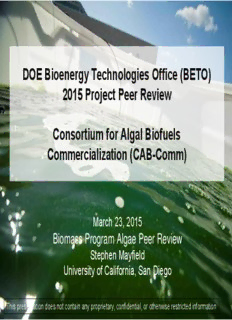
Consortium for Algal Biofuels Commercialization (CAB-Comm) PDF
Preview Consortium for Algal Biofuels Commercialization (CAB-Comm)
DOE Bioenergy Technologies Office (BETO) 2015 Project Peer Review Consortium for Algal Biofuels Commercialization (CAB-Comm) March 23, 2015 Biomass Program Algae Peer Review Stephen Mayfield University of California, San Diego This presentation does not contain any proprietary, confidential, or otherwise restricted information CAB-Comm Goal Statement • Three research areas: – Crop Protection – Nutrient Utilization and Recycling – Genetic Tool Development • Increase in biomass productivity, and creation advanced biotechnology tools to enable the biofuel and bio-product industries. • Co-products now in development with commercial partners, EPA approved successful outdoor GM test paves way future commercial release 2 Quad Chart Overview Timeline Barriers • Project start date: April 2011 • Barriers addressed • Project end date: August 2015 – Crop Protection – Nutrient Utilization and Recycling • Percent complete: 90% – Improved Genetic Tools Budget Partners • Partners Total FY 13 FY 14 Total Costs FY Costs Costs Planned o Sapphire Energy (65%) 10 –FY 12 Funding (FY 15-Project o Life Technologies (35%) End Date DOE Funded $4.43M $3.22M $1.61M $1.77M • Other interactions/collaborations o Heliae Sapphire Share $845K $418K $329K $434K o Triton Health & Nutrition o Euglena Co Life Tech o Solazyme Share $459K $548K $63K n/a o Arctic Foam 3 CAB-Comm Publication Summary Output 2014-2015 Total 2011-2015 Publications 42 82 Presentations 69 227 Patents 7 13 Disclosures 10 26 2 – Approach (Technical) • Overall Technical Approach – In consultation with Commercial Partners, identify the most pressing research needs and assigned a priority status – Identify the research group(s) with the capabilities and expertise to address each priority – Identify milestones and deliverables for each specific project – Continuous assessment of commercial partner needs and relevance of projects under a stage gate review process – Rapidly changing landscape has resulted in elevation of co-products • Demonstrate how project will advance the commercial viability of biomass: – Sapphire projects are directly tied to viability of first integrated algal biorefinery – started operations in 2012 – Life Technologies products entered the market as research tools in 2012 • Purchased by Thermo-Fisher in 2014 – Have added two new partners Heliae and Triton Health and Nutrition • Both have protein co-products that could potentially enter the market in 2016 or 2017 5 2 – Approach (Management) • Critical success factors to technical and commercial viability: – Integration of research projects with commercial partners – Achieve milestones and deliverables on time – Continuous review of projects for progress and commercial relevance • Potential challenges to overcome to achieve project results: – Field is moving fast - need to remain nimble; clear shift to near-term, high-value products – Communication between labs and commercial partners is essential – Life Technologies shift away from synthetic biology resulted in loss of partner – Added two new commercial partners, Heliae and Triton Health and Nutrition • Structure of research projects and milestone review: – Majority of research projects are collaborations between multiple labs and one industrial partner – Milestones and deliverables are reviewed quarterly – Annual stage gate review held for continuation of funding • 2 projects failed to pass reviews and were defunded • Review panel includes both academic and industrial participants – Additional stage gate review held in conjunction with Cost Overrun request process to determine projects to receive additional funding 6 Technical Progress and Accomplishments • SOW and budget initially approved in July 2010 • Final funding authorized April 07, 2011 - No change in SOW or overall budget during this time • Based on CAB-Comm’s Algae Program contributions and the 2013 Peer Review, BETO approved a $2.5M 2014/15 funding: – more comprehensively address the tasks – generate more robust datasets – maximize continued use of and discovery from its algal growth facility, including extended outdoor field tests of GMO algae – enhance further the previously executed deliverables from the original award Progress from the last 24 months will be presented 7 Crop Protection: Impairment of O-antigen production confers resistance to grazing Wzm/Wzt-dependent O-antigen Maturation Simkovsky, Daniels, Tang, Huynh, Golden, and Brahamsha. (2012) PNAS 109:16678-16683. Expanded Model of LPS Synthesis & Resistance Transport to Outer Membrane Ligation Synthesis Transport P 2293 WecA Wzm P WaaL Inner 1126 Membrane 2292 P P MsbA P 1903 P WbdD 2027 1244 Wzt 1887 Lipid A Synthesis 1901 1342 1902 WbdABC Extended Crop Protection Results • Expanded catalog of grazer-resistance LPS synthesis genes • These 10 genes are well-conserved among cyanobacteria • Determined limits of the system: 2 mutations in lipid A-core synthesis provides resistance at a significant cost • Preliminary evidence that cells respond to O-antigen by expressing a coat – possible mechanism of resistance • Can detect grazing-specific compounds for early detection system.
